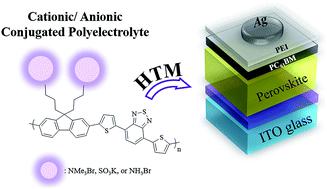当前位置:
X-MOL 学术
›
J. Mater. Chem. A
›
论文详情
Our official English website, www.x-mol.net, welcomes your
feedback! (Note: you will need to create a separate account there.)
Conjugated polyelectrolytes as promising hole transport materials for inverted perovskite solar cells: effect of ionic groups
Journal of Materials Chemistry A ( IF 10.7 ) Pub Date : 2020-11-11 , DOI: 10.1039/d0ta09063h Pang-Hsiao Liu, Ching-Hsiang Chuang, Yi-Ling Zhou, Shih-Hao Wang, Ru-Jong Jeng, Syang-Peng Rwei, Wen-Bin Liau, Leeyih Wang
Journal of Materials Chemistry A ( IF 10.7 ) Pub Date : 2020-11-11 , DOI: 10.1039/d0ta09063h Pang-Hsiao Liu, Ching-Hsiang Chuang, Yi-Ling Zhou, Shih-Hao Wang, Ru-Jong Jeng, Syang-Peng Rwei, Wen-Bin Liau, Leeyih Wang

|
Conjugated polyelectrolytes (CPEs) have developed as promising hole transport materials for perovskite solar cells (PSCs). The conjugated backbone serves as an efficient vehicle for transporting holes, and the electric dipole layer formed through the organization of ionic groups on CPEs may improve the hole collection efficiency. In this work, three CPEs anchored with –N(CH3)3+, –SO3− and –NH3+ ions, denoted as BF-NMe3, BF-SO3 and BF-NH3, respectively, were synthesized and applied as the hole transport material (HTM) of inverted planar PSCs. Replacing the benchmark material, poly(3,4-ethylenedioxythiophene):poly(styrenesulfonate) (PEDOT:PSS), with the three CPEs as the HTM considerably improves the photovoltaic performance of PSCs. The results from scanning electron microscope imaging, X-ray diffraction and time-resolved photoluminescence indicate that the structure of the ionic species rather than the type of charge has a decisive impact on the perovskite morphology. Both cationic BF-NH3 and anionic BF-SO3 layers enable methylammonium lead iodide (MAPbI3) to grow into larger crystals and grains with fewer defects. Moreover, the electrochemical impedance spectroscopy measurements demonstrate that the BF-NH3 and BF-SO3 devices have comparable charge recombination resistance, which is apparently higher than that of the BF-NMe3 and PEDOT:PSS devices. Consequently, the cationic BF-NH3 can act as an excellent HTM as the anionic BF-SO3 and the champion cell based on BF-NH3 exhibits a superior power conversion efficiency of 17.7%.
中文翻译:

共轭聚电解质作为有潜力的倒钙钛矿太阳能电池空穴传输材料:离子基团的影响
共轭聚电解质(CPE)已经发展成为有希望的钙钛矿太阳能电池(PSC)的空穴传输材料。共轭骨架是传输空穴的有效载体,通过CPE上离子基团的形成形成的电偶极层可以提高空穴收集效率。在这项工作中,锚定了–N(CH 3)3 +,–SO 3 −和–NH 3 +离子的三个CPE ,分别表示为BF-NMe 3,BF-SO 3和BF-NH 3。分别合成并用作倒置平面PSC的空穴传输材料(HTM)。用三种CPE代替基准材料,即聚(3,4-乙撑二氧噻吩):聚(苯乙烯磺酸盐)(PEDOT:PSS),因为HTM大大改善了PSC的光伏性能。扫描电子显微镜成像,X射线衍射和时间分辨的光致发光的结果表明,离子物种的结构而不是电荷的类型对钙钛矿的形态具有决定性的影响。阳离子BF-NH 3和阴离子BF-SO 3层都可以使甲基铵碘化铅(MAPbI 3)成长为具有更少缺陷的更大的晶体和晶粒。此外,电化学阻抗谱测量结果表明,BF-NH 3和BF-SO 3器件具有可比的电荷复合电阻,显然高于BF-NMe 3和PEDOT:PSS器件。因此,阳离子BF-NH 3可以作为阴离子BF-SO 3发挥出色的HTM作用,基于BF-NH 3的冠军电池展现出17.7%的出色功率转换效率。
更新日期:2020-11-21
中文翻译:

共轭聚电解质作为有潜力的倒钙钛矿太阳能电池空穴传输材料:离子基团的影响
共轭聚电解质(CPE)已经发展成为有希望的钙钛矿太阳能电池(PSC)的空穴传输材料。共轭骨架是传输空穴的有效载体,通过CPE上离子基团的形成形成的电偶极层可以提高空穴收集效率。在这项工作中,锚定了–N(CH 3)3 +,–SO 3 −和–NH 3 +离子的三个CPE ,分别表示为BF-NMe 3,BF-SO 3和BF-NH 3。分别合成并用作倒置平面PSC的空穴传输材料(HTM)。用三种CPE代替基准材料,即聚(3,4-乙撑二氧噻吩):聚(苯乙烯磺酸盐)(PEDOT:PSS),因为HTM大大改善了PSC的光伏性能。扫描电子显微镜成像,X射线衍射和时间分辨的光致发光的结果表明,离子物种的结构而不是电荷的类型对钙钛矿的形态具有决定性的影响。阳离子BF-NH 3和阴离子BF-SO 3层都可以使甲基铵碘化铅(MAPbI 3)成长为具有更少缺陷的更大的晶体和晶粒。此外,电化学阻抗谱测量结果表明,BF-NH 3和BF-SO 3器件具有可比的电荷复合电阻,显然高于BF-NMe 3和PEDOT:PSS器件。因此,阳离子BF-NH 3可以作为阴离子BF-SO 3发挥出色的HTM作用,基于BF-NH 3的冠军电池展现出17.7%的出色功率转换效率。











































 京公网安备 11010802027423号
京公网安备 11010802027423号